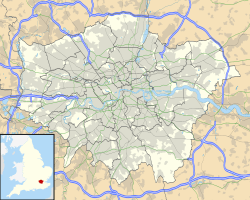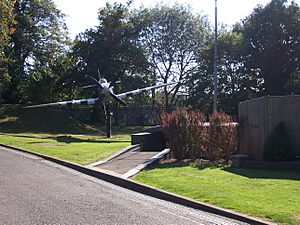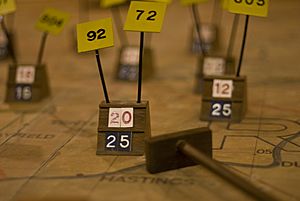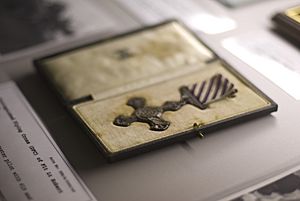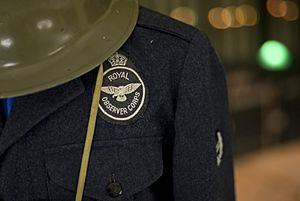Battle of Britain Bunker facts for kids
Quick facts for kids Battle of Britain Bunker |
|
|---|---|
| Uxbridge, Middlesex, England | |

The No. 11 Group Operations Room
|
|
|
Shown within Greater London
|
|
| Coordinates | 51°32′28.5″N 000°27′55″W / 51.541250°N 0.46528°W |
| Type | Underground operations room |
| Site information | |
| Owner | Air Ministry |
| Operator | Royal Air Force |
| Site history | |
| Built | February - August 1939 |
| Built by | Sir Robert McAlpine |
| In use | 1939–1945 |
| Battles/wars | Second World War |
| Garrison information | |
| Occupants | No. 11 Group RAF |
|
Listed Building – Grade I
|
|
| Official name | Group Operations Room |
| Designated | 1 December 2005 |
| Reference no. | 1392556 |
The Battle of Britain Bunker is a secret underground room in RAF Uxbridge, England. During the Second World War, it was a super important control center. From here, brave people directed RAF fighter planes.
This bunker was especially vital during the Battle of Britain in 1940 and on D-Day in 1944. Today, it's a cool place to visit, run by Hillingdon Council. You can explore the bunker and its museum, which first opened in 1985. A new visitor center above ground opened in March 2018.
The Bunker is located at RAF Uxbridge, close to Uxbridge town center and the Underground station.
Contents
How the Bunker Helped Win the War
The Battle of Britain Bunker was a key part of the world's first complete air defense system. This system was often called the "Dowding system" after Air Chief Marshal Sir Hugh Dowding. He was the leader of Fighter Command when it was set up.
The Dowding system connected many different groups. These included Fighter Command, Anti-Aircraft Command, Barrage Balloon Command, the Observer Corps, and early radar systems (called Chain Home). All these groups worked together for the first time. Their main goal was to protect the UK's skies from enemy attacks.
The bunker was home to No. 11 Group Fighter Command. This group was super important for a few reasons:
- Making Big Decisions: The controller in No. 11 Group's Operations Room made critical choices. They decided how many fighter planes to send, which type, and from which squadrons. They also chose when and where to send them. These decisions often changed the outcome of air battles.
- Organizing Squadrons: No. 11 Group also managed seven other airfields where fighter squadrons were based. These included RAFs Kenley, North Weald, Debden, Biggin Hill, Tangmere, Hornchurch and Northolt.
- A Blueprint for Others: The Uxbridge Bunker and its Operations Room were the first of their kind. They served as a model for five other similar group headquarters built across the UK.
Inside the Operations Room, information was displayed in clever ways. Numbered blocks on a large map table showed where friendly and enemy aircraft were. A "tote" board used lights to show what No. 11 Group's squadrons were doing. For example, if they were "At Standby" or "Enemy Sighted." Colored discs showed the weather at different airfields. A special clock system helped track time. All this information came in by telephone from other defense groups.
Building a Secret Underground Base
Work on the bunker started in February 1939 and finished in August 1939. It was built specifically to house the No. 11 Group Operations Room. Before this, their control room was in a building above ground. But after the Munich Crisis in 1938, war seemed likely. The RAF decided they needed a safe, underground place.
A company called Sir Robert McAlpine built the bunker. Its construction was a top secret project. They didn't want enemy spies to find out about it.
The main floor of the bunker is 60 feet (about 18 meters) underground. You reach it by walking down 76 steps. All the important services, like electricity, water, and phone lines, run down these stairs. The walls, floor, and ceiling are about 1 meter thick concrete. This strong design meant that no bombs from that time could break through it. A special ventilation system was also installed. It still works today, providing fresh air to the people working inside.
The Bunker During World War II
Just three days into the Second World War, on September 6, 1939, No. 11 Group had a difficult moment. The new Chain Home radar system reported enemy aircraft for the first time. The controller in the bunker sent out two squadrons, 56 Squadron and 74 Squadron. Sadly, the Spitfires from 74 Squadron mistook the Hurricanes from 56 Squadron for the enemy and shot two down. This was a tragic accident.
In April 1940, Air Vice-Marshal Keith Park became the leader of No. 11 Group. He joined the team working in the bunker.
The German air force, the Luftwaffe, tried to destroy the RAF's Fighter Command. No. 11 Group, controlled from this bunker, saw the most action. They shot down many of the 1,733 German planes that were lost. On August 12, 1940, the Luftwaffe changed its targets. Instead of British ports, they attacked the Chain Home radar system. Luckily, the damage was minor. The next day, known as "Eagle Day" to the Germans, they started bombing British airfields.
Winston Churchill, the Prime Minister, visited the bunker on August 16, 1940. As he left, he said his famous words: "Never in the field of human conflict was so much owed, by so many, to so few." He repeated this phrase in Parliament a few days later. The King and Queen also visited the bunker on September 6, 1940.
After the Luftwaffe started bombing London on September 1, 1940, Churchill visited again on September 15. He later wrote in his memoirs about seeing "all of the bulbs glowed red." This meant that every single No. 11 Group squadron was fighting at the same time.
In December 1940, Sir Trafford Leigh-Mallory took over as the leader of No. 11 Group. The old plotting system, which used wooden markers, was updated. They started using metal markers and magnetic sticks. The light-indicator "tote" system was also replaced with a new slat-board system. After the Battle of Britain, No. 11 Group mainly defended London during the Blitz. They also helped with air support for the Dieppe Raid in 1942. The air operations for D-Day on June 6, 1944, were also controlled from RAF Uxbridge.
After the War: A Museum for Everyone
No. 11 Group moved to a new location in April 1958. Air Chief Marshal Dowding, who the system was named after, unveiled a memorial near the bunker's entrance. It honored the bunker's important role in the Battle of Britain.
Over nine months in 1975, the No. 11 Group Operations Room was carefully restored. It was made to look exactly as it did during the war.
In 1985, a museum was created inside the bunker. Warrant Officer Robert "Chris" Wren helped set it up. The Operations Room then opened for daily visits. In July 2015, the government promised £1 million to help restore the bunker even more. They also funded a new visitor center above ground. Hillingdon Council added another £4.5 million for the new center, which opened in March 2018. Now, many people can visit and learn about this amazing piece of history!


